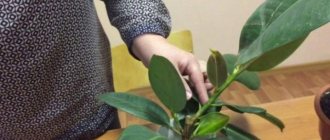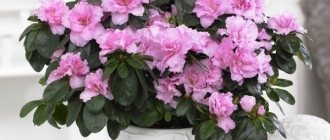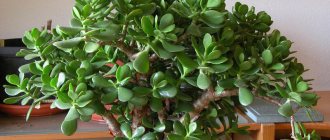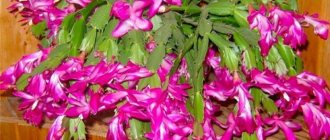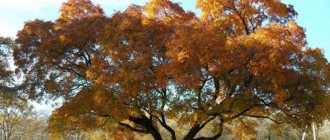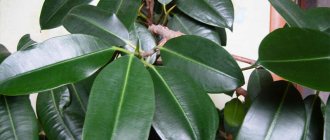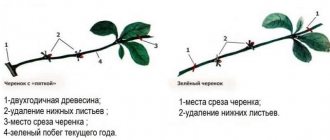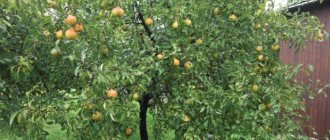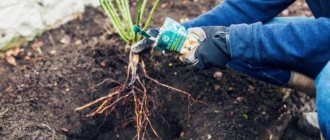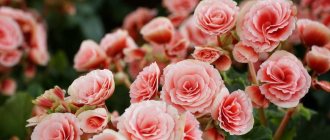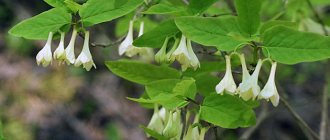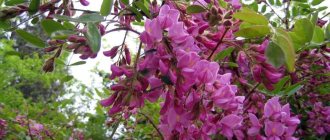Description of the plant
Brugmansia is a genus of tree-like shrubs of the Solanaceae family. The name of the plant was given in honor of the Dutch botanist S. Brugmans. The main growing area is South America; cultivated varieties are grown in warm regions and greenhouses. All parts of the plant are poisonous, phytoncides have a psychotropic effect.
The plant has the shape of a powerful bush with flexible green branches. Single or double leaves can grow up to 50 cm in length. A notable feature of Brugmansia is its two-level, bell-shaped tubular flowers.
When open, they resemble small gramophones and, depending on the variety, are peach, white or pink. The buds remain decorative for up to 3 days and emit a strong aroma that intensifies in the evening. Flowering is possible from the second half of summer to early autumn.
Species diversity
The genus Brugmansia includes 11 species. Only a few of them are grown as garden and greenhouse plants:
- Fragrant, or fragrant . A heat-loving shrub that can bloom throughout the year. Does not tolerate low temperatures well, suitable for planting in containers.
- Golden . Decorative species, characterized by yellowish foliage color. Found only in greenhouses.
- Snow-white, or tree-like . The most famous variety, actively used for hybridization. In its natural environment, the shrub grows up to 3 m, varietal specimens are more compact. The flowers are very large, their maximum length is 25 cm.
- Bloody . It has the greatest frost resistance in the genus. Notable for its bright red flowers and decorative foliage.
- Multi-colored . The peculiarity of this species is the ability to change the shade of the buds as they develop. White or peach flowers can grow up to 50 cm in length.
When choosing planting material, it is recommended to give preference only to resistant hybrids. Brugmansia is thermophilic, so traditional varieties do not take root well in the Russian climate and often die due to frost. You should also pay attention to the size of the shrub; large, medium-sized and dwarf varieties have been bred.
Popular varieties
Not all varieties of Brugmansia are suitable for growing indoors. Many of them grow greatly and become stunted in cramped conditions. Compact varieties are chosen for planting in tubs. The five most famous species of Brugmansia are the most famous in culture.
- Fragrant. A plant brought to our country from Brazil. In nature it grows in hot climates. Well suited for growing in apartments. When favorable conditions are created, it can bloom almost all year round. In its natural environment it reaches enormous sizes - growing up to five meters. The flowers are white or light, with a slight greenish tint, large.
- Golden. It is distinguished by long and large leaves. It blooms with beautiful yellow-orange flowers.
- Snow White. Tree-like variety with large snow-white flowers. In nature it grows up to three meters. In indoor culture, compact hybrid varieties are used.
- Bloody. Large, frost-resistant shrub with rich orange or red flowers. During flowering it emits a pleasant aroma.
- Multi-colored. Prized for its unusual flowering. Newly bloomed flowers are white, and as they mature they take on a peach or orange hue. In nature, multi-colored Brugmansia reaches four meters, and the flowers are half a meter in length.
Read also: Growing fieldfare in the country - watering, pruning, fertilizing, video
Landing
In practice, Brugmansia is planted in open ground with already grown seedlings with a strengthened root system. This simplifies the adaptation process and also accelerates the onset of active flowering of the shrub. Planting material must be at least the first year of growth and free from signs of disease and mechanical damage. Gardeners note that seedlings with closed roots take root faster in temperate climates. It is recommended to carry out the work no earlier than the second half of April, when stable warm air temperatures have established.
Selecting a location
Growing Brugmansia requires a well-lit place with reliable protection from the wind. The plant does not tolerate drafts well, so open areas are not suitable. For planting, you can choose a flower bed next to a fence or structure.
The soil should be moderately moist and breathable. You should not plant shrubs in waterlogged areas, near a pond or well. The plant feels comfortable on fertile chernozems, loams and sandy loam substrates with a neutral reaction.
Landing technology
It is advisable to carry out the work in the first half of the day in dry and windless weather. The planting site should be prepared 2-3 months in advance. It is important to dig up the soil thoroughly and remove all large stones. Step-by-step algorithm for planting seedlings:
- Dig a hole up to 30 cm deep. Lay a layer of drainage up to 10 cm thick at the bottom.
- Fill it with nutrient substrate 2/3 of the total volume. A mixture of humus, garden soil and peat in equal proportions is suitable for this purpose.
- Place the plant in the center of the hole. Fill the voids with soil, compact the area around the tree trunk.
- Mulch the ground with a thick layer of peat, wood chips or sawdust. Pour warm water at the rate of 10-12 liters per square meter. m.
The bush has thin shoots that can easily break when exposed to wind. It is recommended to install a support or supports immediately after planting to avoid this problem.
Planting Brugmansia and caring for it
Whether it is a seedling or an adult Brugmansia, the plant that will enter the flowerbed in the spring has previously been in a state of relative dormancy.
With the arrival of warm weather, the vegetation processes of the decorative perennial become more active. This means that the Brugmansia tree can be prepared when planted in the garden:
- If the plant was in a heated room in winter, it needs hardening. To do this, Brugmansia is gradually accustomed to fresh air, prolonging the “procedure” day after day.
- When wintering Brugmansia is organized in a cool basement or other room at a temperature of about +8 ° C, the plant must be taken out into the light, where its development will quickly resume.
Brugmansia is a fast-growing plant, so already from April, while the tree is in the tub, it begins to be fed with a mixture with a predominance of nitrogen. This stimulates the growth of new shoots and foliage.
When should you plant Brugmansia in open ground? This can be done only when the danger of returning cold weather has completely passed. In central Russia, this time comes no earlier than mid-May or June.
A summer resident has two options for planting Brugmansia:
- into open ground in order to remove the plant again in the fall and place it in a tub together with a lump of earth;
- in a large container so that the tree grows like a tub plant.
Both methods have their advantages and disadvantages. It is difficult to remove a large plant from the ground without damaging the root system and drooping shoots with flowers. And in a tub, Brugmansia needs more frequent watering and frequent feeding. In addition, the roots of the flowering tree are growing, and it will soon need to be transplanted into an even larger container.
Selecting the shortest varieties will help you save energy and maintain the decorative appearance of Brugmansia for longer. They are as beautiful as trees up to 3 meters tall, but are more compact and require less pruning.
To make caring for Brugmansia after planting in open ground easy and effective, look for a sunny area with good protection from the wind for the plant. This will help create the most suitable microclimate for the tropical guest and provide her with conditions for constant flowering.
Selection of suitable soil is equally important. To grow and produce many large flowers, the plant requires a nutrient substrate containing:
- 1 part loam;
- 2 parts lowland peat;
- 1 part of well-rotted humus, cleared of coarse inclusions.
Before planting in a pot, the soil mixture should be disinfected by calcining it in the oven or spilling it with a deep pink solution of potassium permanganate. It should be taken into account that Brugmansia will require a large pot of 10–30 liters, depending on the size of the root system.
If you have to care for Brugmansia in the open ground, before planting, as in the photo, the soil selected from the pit is also enriched with humus and peat is added as a leavening agent, and if necessary, sand.
Rules of care
Brugmansia requires high-quality and regular care. The plant reacts negatively to any changes in growing conditions, so it is important to control soil moisture and timely fertilizing and pruning. Care instructions:
- The plant needs frequent and abundant watering. Throughout the summer, procedures are carried out every 2-3 days; in hot weather, it is recommended to additionally spray the leaves. Closer to summer, the frequency of water application is reduced to a minimum;
- It is important to maintain the breathability of the soil. It is advisable to carry out loosening every week, combining the procedure with weeding;
- feeding should be regular, the optimal frequency is once every two weeks. Before flowering begins, complex mineral compositions for flowering crops are added, then it is advisable to use potassium-phosphorus mixtures with the addition of wood ash.
Important attention should be paid to pruning the bush, which is required from the second year of growth. It is recommended to carry out the work in March or autumn before the active growing season begins. First, all old and weakened shoots are removed, leaving the main trunk and side branches - it is on them that flowers are formed.
To enhance development, all young vegetative parts are cut to 30% of their length, and the cut areas are treated with wood ash or activated carbon. During the flowering period, it is advisable to pinch the buds to stimulate the formation of new flowers.
Wintering
The shrub is sensitive to low temperatures and begins to shed its leaves when the temperature drops to 5 o C. In the Russian climate, Brugmansia is dug up at the end of September and then placed in a spacious container filled with nutritious soil. The plant can be stored indoors with a temperature in the range of 10-15 o C. During the entire dormant period, spraying and rare watering should be carried out to avoid drying out.
Sometimes the first buds begin to appear in the second half of winter. In such a situation, the plant should be moved to a bright and warm room and fertilized with complex fertilizer. Transplantation to a permanent place is carried out only in the spring after warming.
Tips for growing Brugmansia
Lighting . A light-loving plant, in case of insufficient light it is better to keep it in a cool room in a dormant state until spring.
Temperature . Brugmansia loves warmth; temperatures below +5 are dangerous for most varieties. In summer 22-26 degrees is quite suitable
Watering. In spring and summer, during rapid growth, water abundantly. After the flowers appear, growth usually stops, so you can water less. In winter, watering is scanty, just so that the earthen ball does not dry out.
Fertilizer . They say that it is impossible to overfeed Brugmansia; all feeding only benefits it. In the spring, during growth, fertilize with complex fertilizer once a week so that the bush grows green mass.
Reproduction methods
There are several ways of vegetative propagation of Brugmansia. The choice of a specific method depends on gardening skills, the age of the bush and the characteristics of the variety.
Cuttings
Planting material is obtained during planned pruning. Cuttings can be immediately placed in a growth stimulator solution until the first roots appear. Then the seedling is transferred to a container with soil, where the plant remains until next spring. The method allows you to preserve cellular qualities and enhance the onset of flowering.
By layering
In May, select several strong and healthy shoots from the lower part of the bush. Dig a groove in the ground and place a little wood ash mixed with sand at the bottom. Bend the shoot into the ground, pin it and cover it with a nutrient mixture (some gardeners use damp sphagnum moss). Rooting occurs within 30-40 days, then the shoot is cut off and planted in a container. Transplantation is carried out no earlier than next spring.
Seeds
In practice, this method is used less often than others. The daughter plant does not retain varietal qualities; flowering is possible only in the second year of life. Seeds quickly lose their viability, so before planting they are soaked in a growth stimulator.
Sealing into individual containers is planned for the end of January. It is advisable to pick young seedlings only in June. Throughout the first year, you should increase the frequency of fertilizing and cover the plants at night.
Reproduction
There are several effective ways to propagate Brugmansia:
Growing from seeds.
- To obtain seeds, the crop requires artificial pollination. The seeds are first soaked in warm water and planted in February or early March. The seeds are planted in a damp sand-peat mixture to a depth of 0.5 - 1 cm, then covered with a protective film or glass. After the seedlings appear, the film is removed, and the container is moved to a place with indirect sunlight and the plants are regularly sprayed. At the next stages of development, the sprouts are moved to separate pots.
Seeds can sprout 2 weeks after planting, but it is possible after 2.5 months. You should expect sunrise, regardless of the time passed after landing.
Propagation by cuttings.
- Propagation by cuttings is the fastest way. Cuttings should be harvested in spring or autumn. The best option for cuttings is annual shoots with buds. Having selected the cuttings, they are cut and placed in a container with water and activated carbon. When white dots appear on the stems, the cuttings can be transplanted into a pot, placing it in a well-lit place.
It is important to take cuttings from a tree at least 85 cm high in order to set high buds. It must be taken into account that rooting cuttings in water may not be suitable for all species.
Reproduction by layering.
- Propagation by layering is used in May - June; the plant does not grow tall, but the flowers will not suffer from this. In the upper part of an adult bush, you need to select last year's strong shoots. Make a cut on each shoot and sprinkle it with a stimulant for root growth. Then place wet moss around the cut and wrap everything in a plastic bag, securing it with a thick thread. For a month, use a medical syringe to moisten the moss. When the roots appear, the shoot needs to be cut off and all leaves and colors removed, moss removed and planted in a prepared place, being careful not to be exposed to direct sunlight.
Diseases and pests
Infestation by harmful insects and diseases is rare. Most often, when growing Brugmansia, problems arise due to improper care. One of the main difficulties is the lack of flowering. Usually observed at low average daily temperatures and overuse of nitrogen-containing fertilizers.
In addition, violation of the watering regime and insufficient lighting can lead to early leaf fall. Against the background of waterlogging, the buds of the bush begin to fall off and fruits do not form. The problem can be solved by correcting the application of water and transplanting to a brighter place.
Features of growing Brugmansia from cuttings
You can grow Brugmansia from cuttings when the plant is one year old. The general growing strategy will be approximately the same:
- first, cuttings are formed;
- then preliminary rooting of the cuttings is carried out;
- young seedlings are planted in temporary containers, where the rooting process is completed;
- Seedlings ready for transplanting are planted in a permanent place - in a pot or open ground.
Differences in cultivation manifest themselves primarily in the methods of obtaining cuttings. Depending on the time of year when planting material is harvested, the mechanism for its preliminary preparation will be different.
When is the best time to take Brugmansia cuttings?
Usually cuttings are carried out in the fall, in September, or in the spring, in March.
Spring cuttings are more preferable, since in the spring the flower has more active sap flow and it takes root faster. On the other hand, the first flowering of a new plant during autumn cuttings will occur almost a year earlier.
Brugmansia cuttings in autumn
In this case, take branches with a lignified trunk. Theoretically, Brugmansia can be propagated using green cuttings, but the result will be much worse. Preparation of cuttings is carried out before the onset of frost.
Brugmansia, the cuttings of which were cut in the fall, will bloom the following summer.
Brugmansia cuttings in spring
Brugmansia can also be propagated by cuttings in the spring. Spring cuttings are carried out in a different way. In this case, young shoot tips are used as planting material.
Spring cuttings provide better seed material, but such Brugmansia will bloom, at best, only next year.
What to do if Brugmansia is caught in frost? + 4 ways to winter these flowers
If Brugmansia is not removed from the street in advance, frost may catch it.
What to do if Brugmansia still froze during the first frost? And how to store this plant in winter?
I'm telling you from personal experience.
If young branches are damaged by frost, they need to be pruned. All dead leaves and buds should also be removed. Healthy leaves should be left.
If Brugmansia grows in the ground, then it needs to be dug up before the first frost. The diameter of the dug clod of earth should correspond to the diameter of the container in which Brugmansia will be planted. The roots should be shortened. After transplanting into a container, water the soil.
WINTERING BROGMANSIAS
Method number 1. In the basement
You shouldn’t put Brugmansia in the basement right away. If possible, first send the Brugmansia to an overexposure, for example, to a garage or barn. When the temperature reaches 8 degrees Celsius, the flower can be hidden in the basement.
In winter, plants should be watered once a month. At the end of February - beginning of March, Brugmansia needs to be brought into the light of day.
Before landing on the mainland, they need to be kept in an apartment, closer to the window. Don't forget to feed with nitrogen fertilizers.
Interesting fact:
In the spring, in my basement, white thread-like roots began to appear over almost the entire surface of the brugmansia trunks.
That is, Brugmansia itself took cuttings in unfavorable conditions, thus trying to survive. This suggests that any part of Brugmansia takes root well, even thick trunks.
Method number 2. In a cold room
If there is no basement, Brugmansia can easily overwinter in a cool room where the temperature does not drop below 8-10 degrees Celsius. Closer to spring, it will begin to come to life and produce leaves. In this case, the room can be light or dark.
Method No. 3. In a warm room
Brugmansia, in principle, does not need rest. It can continue flowering in your apartment near the window. But if she doesn’t like something, she will drop the leaves. It may even be left without a single leaf. But don't worry about it! She will recover later.
A prerequisite for wintering in an apartment is the fight against
spider mites , which are activated in a warm and dry room and severely damage the plant.
If the leaves turn yellow and fall off, spray the flower with anti-tick chemicals (fitoverm) .
This wintering will provide your flower with the earliest and most luxuriant flowering.
Method number 4. Cuttings
If there is absolutely no place for wintering, cut Brugmansia into cuttings - branches and trunk. Place the cuttings in plain water. Root stimulants are not required.
After two months, when the root system is well developed, plant the cuttings in separate pots. Let them grow on the windowsill. By spring you will have full-fledged plants that will bloom this summer. Abundant fertilizing will speed up flowering.
How to propagate Brugmansia from cuttings
When propagating Brugmansia by cuttings, you should decide what result is needed in the end. If the goal is to get a flowering plant as soon as possible, and the percentage of rooted material is unimportant, choose cultivation with autumn cuttings.
In this case, it is necessary to prepare seed material with some reserve, since the method of forming autumn cuttings allows this. On average, autumn seeding material (in the number of cuttings) can be obtained approximately 3 times more than spring seeding.
If the goal is to obtain higher quality seed material, with a higher survival rate, then you will have to sacrifice the speed of the process; in the best case, you will get a flowering plant only a year and a half after the start of cuttings.
The number of cuttings obtained in the spring is significantly less than those obtained in the fall, since the number of young shoots of the plant is limited. On the other hand, they have better survival rate due to their rapid growth and rooting rates.
Below are the features of growing Brugmansia using planting material cut at different times of the year.
Rules for taking cuttings
Depending on when you plan to harvest planting material, the harvesting rules will differ significantly.
Autumn harvesting
The branches are divided into cuttings in such a way that each of them has at least three buds. The length of the segment in this case is not critical; even short shoots 30-40 mm long will do. In this case, very large leaves should be cut off; small leaves and shoots can be left.
Spring harvesting
During spring harvesting, exclusively young shoots up to 20 cm long are used. The lower leaves are cut off from them, and the shoot itself is placed in a container with water, which is covered with a plastic bottle. The neck and bottom of this bottle are cut off.
To improve root formation and to prevent leaves from falling from spring cuttings, daily spraying of seedlings with warm water is used.
Preparation of cuttings
Depending on when the cuttings were formed, their preparation will also be different.
During autumn cuttings
The cut cuttings should be installed in a substrate that is a mixture of garden soil and perlite. If rooting occurs in a greenhouse, there is no need to cover the cuttings. If rooting is carried out at home, the box with cuttings should be covered with film. The duration of the rooting process can be quite long - up to 1.5 months.
Rooting Brugmansia cuttings in water has worked well. To do this, the cuttings should be placed in a container with a small amount of water, to which 2 tablets of activated carbon have been added. The container with water should be placed in a dark room.
After the cuttings take root, they must be transplanted into individual plastic containers - seedling pots. Further care of the sprouted cutting includes all the necessary procedures for working with plants: watering, fertilizing, weed control, etc.
When cutting in spring
Within a few weeks, small roots will appear on the young cuttings. To finally root Brugmansia cuttings, they should be transplanted into the ground. The composition of the soil can be as follows:
- sand – 1 part;
- perlite – 1 part;
- peat – 2 parts.
After about 15 days, the seedlings can be transplanted to a permanent location. This can be a pot or temporary container where the plant will remain until it is transplanted into open ground.
Landing
Further actions for propagating Brugmansia by cuttings are no longer differentiated by how the cuttings were obtained and how their preliminary germination was carried out.
After the process of formation of the root system is completed, care for a young, full-fledged seedling is the same for seed obtained both in spring and autumn.
The criterion that the time has come for planting a young seedling in a permanent place is that its root system almost completely fills the entire free space of the individual container. This moment is easily determined visually either by the roots that have taken up all the space in the jar, or by the raised substrate in a temporary container, from under which the whitish roots of the plant are already protruding.
Planting is carried out in large containers. The volume of the pot must be at least 15 liters. Drainage is placed at the bottom in the form of small pebbles or expanded clay 3-5 cm high. Humus or compost is placed on the drainage layer; the height of the organic layer is 5-7 cm. The use of manure is not recommended, since it increases the acidity of the soil, and the soil should be neutral or slightly alkaline.
The approximate composition of the soil is as follows:
- leaf soil - 2 parts;
- sand – 1 part;
- peat – 1 part.
If the soil is too dense, it is recommended to increase the share of sand to 1.5 parts.
The seedling is placed in a pot and covered with soil strictly to the level of the root collar.
After lightly compacting the soil, water the plant.
Caring for a seedling is similar to caring for an adult plant, with the exception of issues related to pruning the plant. Brugmansia is not pruned before transplanting into open ground.
Care consists of abundant and frequent watering without stagnant water, as well as the application of mineral and organic fertilizers.
Watering is carried out as the top layer of soil dries out. All soil in the pot should be moderately moist.
In the first month after planting, the plant will require nitrogen fertilizers. It is recommended to use urea in doses appropriate for growing ornamental plants. The frequency of application is 10 days.
In subsequent months, it is necessary to apply phosphorus-potassium fertilizers, alternating with organic matter (mullein or a solution of 1 to 10 bird droppings). The application interval does not change - 10 days.
Reproduction of Brugmansia by cuttings 1
Author: Igor February 18, 2021 Category: Reproduction
Video of Brugmansia propagation by cuttings. We have already shown two videos about a wonderful and very beautiful perennial flower - Brugmansia. In the first video we showed how Brugmansia blooms, told how to care for it, and in the second we showed repeated flowering in the fall. Today I want to talk about one of the methods of propagating Brugmansia.
Brugmansia cuttings - video
In autumn, when the temperature drops - 5-6 °C is already a critical temperature for Brugmansia - it needs to be dug up. That is, the upper part (aerial part) is cut off from the ground by approximately 40 cm. I replant it into a container, depending on what kind of roots it is, or into a box or some other container. I cover it with soil, the same one where it grew, and bring it into a cool room, into the basement. The temperature in the basement should be at least 6 °C; if stored in a room, the temperature should be from 10 to 12 °C - this is the optimal temperature for storing the flower.
You don't have to cut the flower at all. If you have conditions where you can preserve it in the same form as it grew, this will be even better, since it will begin flowering earlier and will bloom more profusely. If you want not only to preserve the plant, but also to propagate Brugmansia, then cut the upper part that was cut into cuttings, about 15-20 cm, and you can put it in, say, a 5-liter polyethylene container with soil, make drainage holes at the bottom. Water it, put it in the basement, let it stay like that until the beginning of February. In February, you need to take out this container and place it in a brighter place, continue to water it, and then Brugmansia will begin to develop, roots and shoots will begin to appear.
This year I decided to conduct an experiment. I put two cuttings in a box with damp sand, slightly damp, this box was in my basement. A week ago I took out these two cuttings, cut off the lower part, renewed it, poured charcoal or activated carbon into a jar, poured a little water, about 2 cm. Roots most often form at the border of water and air. There is more oxygen in the upper part of the water, and oxygen is needed for the formation of roots. What is activated carbon or charcoal for? To prevent the water from rotting. Periodically you need to look, if the water begins to become cloudy or some kind of mucus appears, you must definitely change the water. The water should be settled, warm, and we also add charcoal or activated carbon. These cuttings have been standing in water for a week now. I want to show you: callus has begun to form, that is, these are the beginnings of roots, these little white dots. But in this place – this kidney has awakened.
Transplantation into open ground
After the seedling has grown stronger, it is moved to a larger pot or the plant is transplanted into open ground. In open ground in a sunny area, it is necessary to make a hole 50 cm deep and 70-80 cm in diameter. A drainage layer in the form of broken bricks or crushed stone is laid at the bottom of the hole. A layer of humus or compost is placed on top of the drainage layer.
The young plant is replanted entirely with the lump of earth in which it grew in the pot. To avoid injury to the root system, the transshipment method should be used. The space around the lump is filled with earth, it is lightly compacted and watered.
How to grow garden Brugmansia, winter care and reproduction
The genus Brugmansia includes seven species of beautifully flowering trees and shrubs from the Solanaceae family. In nature, the culture grows in the subtropical regions of Central and South America and the southern states of North America.
Previously, all plant species belonged to the genus Datura (Datura), but in 1973 they were officially separated into a separate genus. The high decorativeness of Brugmansia and easy care in the open ground have made this tropical beauty very popular among gardeners.
Wintering Brugmansia
Low temperatures are dangerous for the heat-loving Brugmansia, so without waiting for frost, it is removed from the soil and transferred indoors. Wintering of Brugmansia takes place:
- at an air temperature of 5–8 °C in a dark room, even a basement;
- in a room with air heated to 10 °C, but with lighting and watering.
In the first case, the plant needs to be prepared for changing living conditions by gradually reducing the intensity of watering.
Until the second ten days of March, that is, before planting and caring for Brugmansia in open ground, the plant is pruned. This operation will make the crown more compact, and will ensure the flowering that takes place on young shoots is splendor and duration.
Brugmansia has inherited the “habits” of the garden nightshades that are well known to summer residents: peppers and eggplants. It does not form buds until branches appear on the stem.
Therefore, during pruning, such “forks”, as well as small side shoots in the upper part of the crown, must be left. Damaged or excessively elongated branches must be removed or shortened. If the brugmansia on the site is grown from a stem cutting without an upper growing point, such a plant can be pruned a year after the first flowering, that is, at the age of 2–4 years.
Description
Depending on the type, the perennial takes the form of a bush or small tree with a wide branched crown. The leaves are large, ovate up to 30 cm in length, sometimes pubescent, arranged in tiers on the shoots.
A characteristic feature of the culture is its impressively sized tubular-bell-shaped drooping flowers, which can reach up to 50 cm in length, for which the culture received the second name “angel trumpets”. Their color varies from white to orange, red and even lilac.
Flowers can be simple, double or even two-tiered. In summer, during one flowering period, there can be several dozen of them on one tree.
In most species, the flowers emit a very strong but pleasant aroma, which intensifies in the evening. The flowering period lasts from June to October, with the most fragrant flowers appearing in August. After flowering, fruits and seeds are set.
How to grow beautifully flowering weigela can be found in this article
At the initial stage of the growing season, young Brugmansia seedlings grow straight in one shoot until they reach their first main fork at a height of 50-150 cm (depending on the species or variety). Then the trunk begins to branch.
All parts of the crop are potentially poisonous, seeds and leaves are especially dangerous, so all procedures related to caring for Brugmansia both in the open field and at home must be carried out with gloves. In regions with frosty winters, Brugmansia is most often grown in large pots, which are brought into the house in the fall.
Brugmansia
The very beautiful Brugmansia is directly related to the nightshade family (Solanaceae). Previously, this flower belonged to the Datura genus, but then, due to several specific properties, it was separated into a separate genus. Brugmansia candida is grown as an ornamental flower. It is a small tree or shrub (which loves warmth very much) with many bright drooping bell-shaped flowers that are impressive in size. In the wild, this species can be found in South America.
This plant is known in the literature under the name “ intoxicating tree ”. This is due to the fact that all its parts contain a strong intoxicating substance. It is also called “angel trumpets” due to its flowers of extraordinary beauty.
This plant has long been grown in areas with mild winters as a garden plant. For example, in countries such as Crimea, Southern Europe, and the Caucasus. If it is grown in a harsher climate, it can freeze entirely. More recently, more and more new varieties have begun to appear, differing in their color, and this has attracted the interest of a large number of flower growers.
It turned out that this plant grows well on the balcony in a tub. A spectacular tree or bush can also decorate a patio or terrace. And after the gorgeous bell flowers, painted in bright colors, bloom on it, it will become clear that Brugmansia is the best indoor plant.
The bush can reach a height of 150–200 centimeters, but in the wild this plant is much taller. In the spring-summer period, active and very rapid growth of shoots is observed, but they become woody very slowly. To form a beautiful tree or bush, it is necessary to systematically remove unnecessary side branches.
The oval-shaped petiolate leaves of this plant have smooth edges. There is also a small fluff on their surface. The root system also grows quite quickly. It forms a dense lump at the surface of the soil, and then sends roots deep into the soil, which are very long.
Brugmansia owes its popularity to its lovely flowers. Hanging tubular flowers have a diameter of 15 centimeters and a length of 20 to 25 centimeters. They are very fragrant, and their aroma is especially noticeable in the evening. The flowers are colored yellow, white or pink. There are also varieties of flowers whose colors gradually change along their entire length. Flowering later. It begins after the aerial part is completely formed. Also, flowering is wavy in nature, and several occurrences are observed.
It is curious that in Brugmansia, grown as a garden plant, the formation of buds occurs at the end of the summer period, after it becomes quite cold at night. That’s why you shouldn’t be afraid to move a tub of flowers outside in the spring. The main thing is that there is no threat of frost. Lowering the temperature at night to 5 degrees does not harm the flower.
Popular species and varieties in gardening
Brugmansia aurea is a tree that in nature can reach 6 meters, but in pots its growth is limited to 2 meters. Flowers in golden or cream shades.
Brugmansia candida - grows up to 4.5 m in height. It is an interspecific hybrid with white, slightly pink or cream flowers, intensely fragrant in the evenings. Varieties: “White Angel”, terry form “Adretta”, mini bush “Wooly White”.
Fragrant Brugmansia (Brugmansia suaveolens) . One of the most popular species, which attracts with its variety of varietal forms, hybrids and the heady aroma of yellow, pink, cream and white flowers. The most spectacular variety “Tricolor” with a unique combination of flowers of different colors. "Ambizu" is a dwarf form of bush with yellow flowers, pink Brugmansia "Aromagia rosea".
variety "Tricolor"
You can find many terry hybrids on sale, for example, “Angels Innovation”, “Angels Suprise”, “Angels Sunexplosion”, “Rosa Zauber”, “Miss October”, “Bolero”, “ANGELS ENJOY”, “Edna”. The unique hybrid form of Brugmansia cubensis is striking in its unusual shape of the flower corolla.
There are also decorative foliage varieties of the Variegata group: “Maya”, “Snowbank”, “Sublime”, “Sunset”, “Apricot Queen”.
Features of caring for Brugmansia in open ground
Choosing a place to plant Brugmansia
Brugmansia is planted in fertile, humus-rich, permeable soil, so it is advisable to add two parts of coarse sand to the substrate. If the plant is grown in a pot, then a drainage layer of expanded clay or small crushed stone must be laid at the bottom.
Choose a place for growing that is sunny or slightly shaded, protected from the wind. In full sun, flowering will be abundant and long lasting. At high temperatures, it is useful to spray the crown with warm water.
Watering
The plant tolerates summer heat well provided it is watered regularly, since the crop is very sensitive to lack of moisture. The soil should always be moderately moist, otherwise the tree may lose leaves and flower buds. This is especially true for potted crops that require daily watering in hot weather. In cool weather, the top layer of soil should dry out between irrigations.
Feeding and pruning
The tree grows quite actively, so weekly feeding is required during the season. You can use multicomponent fertilizers for decorative flowering plants. The plant develops well when potassium-phosphorus fertilizers are applied. Use 1 teaspoon per 5-6 liter pot. Fertilizers are diluted in water and applied during watering. With a lack of nutrients, the tree sheds flower buds and the leaves turn yellow. At the beginning of September, feeding is stopped.
The culture responds well to pruning, which allows you to form a compact crown and control plant growth. Shorten the shoots in the spring before growth begins. Flowers are formed on apical Y-shaped shoots, so you can only shorten their tops to a length of 3-5 cm. Flowering is stimulated by the removal of shoots that develop at the base of the central trunk.
Caring for Brugmansia in winter
The culture is sensitive to temperatures below 5 °C, so brunmansia is brought indoors for wintering. In a warm room with bright sunlight or additional lighting with the usual regime of watering and fertilizing, the plant retains its foliage and continues to bloom for another 2-3 months, but this can weaken the tree, which needs a period of rest.
For rest, the crop needs cool conditions of 6-9 °C, partial shade and limited watering, but the earthen ball should not dry out completely. In relation to illumination, the principle is this: the lower the temperature in the room, the lower the light requirements.
At the end of March or early April, the plant is transferred to a warm and bright room, and watering is gradually increased. After 2 weeks, they begin to apply fertilizers. The pot is moved to the open air when the night temperature rises above 9-10 °C.
Transfer
Potted crops are replanted in early spring, when the roots have completely entwined the earthen ball.
The procedure is carried out using the transshipment method. For growing, the best soil mixture is made from universal soil, peat, compost and sand, taken in equal proportions. There must be drainage holes and a layer of expanded clay at the bottom of the pot. Place the plant in the pot and fill the empty spaces with substrate, tamp down and water well.
Reproduction of Brugmansia
The crop is propagated by seeds and vegetatively by rooting cuttings.
Growing Brugmansia from seeds
Only Brugmanisa Arborea hybrids are self-pollinating; other forms require artificial pollination to produce seeds. Sowing is carried out in February or early March, after soaking for 24 hours in warm water. Sow in a damp sand-peat mixture to a depth of 0.5-1 cm and cover the container with film or glass.
With moderate substrate humidity and a temperature of 20-22 °C, seedlings appear after 10-30 days. After the sprouts appear, the cover is removed, the container is moved to a place with bright, diffused light, and the plants and soil are sprayed daily with warm water. At the stage of 4-5 leaves, the seedlings are picked and transplanted into separate pots with nutrient soil.
Propagation of Brugmansia by cuttings
Apical or stem cuttings can be taken throughout the growing season, but the best results are achieved in May. For propagation, parts of young shoots with a “heel” and 3-5 internodes are cut off, the lower leaves are removed, and the upper ones are cut to half. Sections of cuttings are dipped in rooting hormone before planting. Then they are buried to a depth of 3 cm in a damp mixture of perlite and peat.
Cover the cuttings with a transparent bag or jar and place the container in a bright place. The soil should be moderately moist at all times. Usually rooting occurs within a month. After growth begins, Brugmansia seedlings are transplanted into new pots with a fertile mixture. After a month, it is recommended to pinch the top to encourage branching. Flowering occurs after 1-2 years.
The second method of planting cuttings is horizontal. In this case, roots are formed along the entire cutting. Another simple method of root formation is to immerse the cuttings in warm, soft water by 2-3 cm. It is useful to add pieces of activated or charcoal to the water. The water must be changed every 2-3 days. After 2-3 weeks you will be able to see the beginning of root development.
Problems in caring for Brugmansia outdoors
Plants can be attacked by spider mites and aphids. For prevention, the crop is treated with special preparations twice a season.
Spider mites on leaves
A pale leaf blade with dark green blurry spots is a sign of the tobacco mosaic virus.
Yellowing of leaves Falling of leaves and flower buds is most often caused by nutrient deficiency, excess nitrogen in the soil, improper watering regime or various types of diseases.
High air humidity along with coolness or infection from other crops often cause the development of fungal or bacterial diseases: anthracnose, powdery mildew, bacterial spot, root rot.
Brugmansia: planting, growing, care and propagation in open ground. 75 photos of a beautiful flower
From the beginning of summer you can feed with fertilizer for flowering plants.
Transplant . When growing Brugmansia from a cutting in a pot, as it grows, it must be transferred several times a season to a larger pot without destroying the earthen ball. Each time you replant, you should add mineral fertilizer or a little chicken manure to the pot.
The soil . Brugmansia grows quickly, so it requires nutritious soil. The acidity of the soil is not particularly important. A mixture of peat, humus and sand in equal quantities works well. You can use store-bought palm mix.
Outdoor maintenance . In summer, be sure to take the tub with the Brugmansia flower out into the open air, into the yard, onto the open veranda or onto the balcony. A sunny but ventilated place is suitable; a too hot glazed balcony on the south side is not suitable. Grows well on the balcony, where there is sun for several hours in the morning or at sunset.
Important ! The pot should be heavy or secured in place. The wind causes the large plant to topple over.
Trimming . Brugmansia, like other nightshades, is prone to the formation of stepsons (young shoots between the trunk and the leaf); the stepsons must be removed in order to speed up the onset of flowering.
With the onset of cold weather, the plant must be moved into the apartment, and it must be trimmed. You can safely trim the upper forks of the shoots; after rooting, they can bloom.
Wintering . In winter, water less often and do not fertilize; the less it grows, the less the shoots stretch from lack of light. It is better to keep in a cool place. It is advisable to provide lighting so that there is at least 12 hours of daylight per day. In the spring, watering is increased and Brugmansia begins to be fed, then transplanted into a new pot.
If it is not possible to store the plant in a bright room in winter, or you want to preserve Brugmansia growing in the garden, then there is another way. The plant is trimmed so that only woody parts remain and placed in a cool, dry basement. In the same way, a garden bush is dug out of the ground and, if necessary, divided into several parts. Each part is placed in a large pot and brought into the basement.
Reproduction . Propagated by seeds and cuttings. Propagation by cuttings is more reliable; plants retain the properties of their parents. Seedlings grown from seeds can bloom only after several years.
Brugmansia cuttings come in two types: stem and apical. Apical branched cuttings are preferable. Once they take root, you can expect flowering.
Cuttings are taken 15-20 cm long, large leaves are removed and placed in water. Roots appear at the end of the cutting. You can plant them deep in the soil; the roots then grow along the entire length of the deepened cutting. Along with the roots, new shoots also grow from the lateral buds. A month after planting, the roots fill the pot and begin to emerge through the hole in the bottom. It's time to transfer it to a larger pot.
